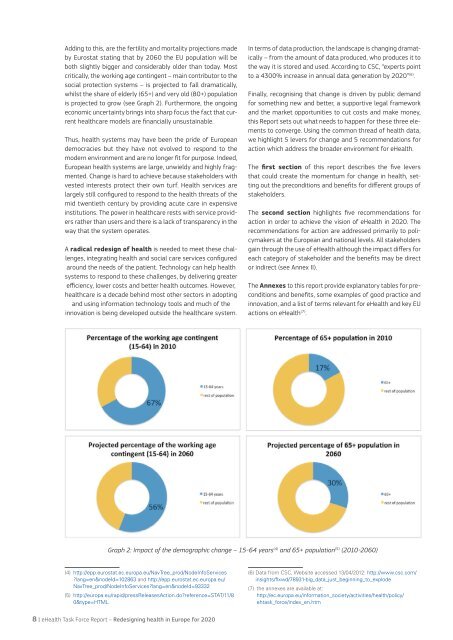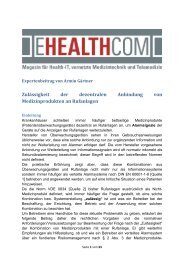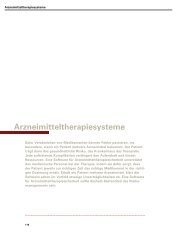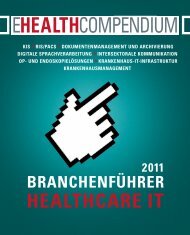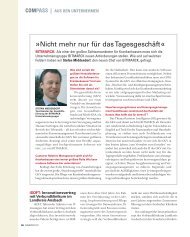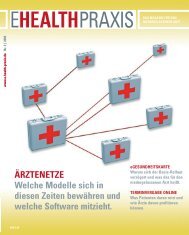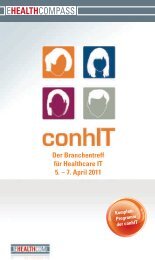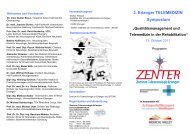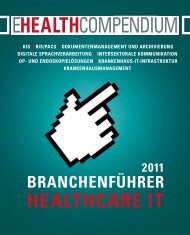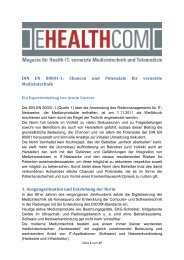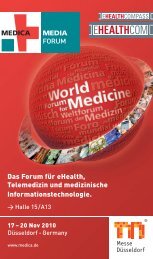eHealth Task Force Report - E-Health-Com
eHealth Task Force Report - E-Health-Com
eHealth Task Force Report - E-Health-Com
Create successful ePaper yourself
Turn your PDF publications into a flip-book with our unique Google optimized e-Paper software.
Adding to this, are the fertility and mortality projections made<br />
by Eurostat stating that by 2060 the EU population will be<br />
both slightly bigger and considerably older than today. Most<br />
critically, the working age contingent – main contributor to the<br />
social protection systems – is projected to fall dramatically,<br />
whilst the share of elderly (65+) and very old (80+) population<br />
is projected to grow (see Graph 2). Furthermore, the ongoing<br />
economic uncertainty brings into sharp focus the fact that current<br />
healthcare models are financially unsustainable.<br />
Thus, health systems may have been the pride of European<br />
democracies but they have not evolved to respond to the<br />
modern environment and are no longer fit for purpose. Indeed,<br />
European health systems are large, unwieldy and highly fragmented.<br />
Change is hard to achieve because stakeholders with<br />
vested interests protect their own turf. <strong>Health</strong> services are<br />
largely still configured to respond to the health threats of the<br />
mid twentieth century by providing acute care in expensive<br />
institutions. The power in healthcare rests with service providers<br />
rather than users and there is a lack of transparency in the<br />
way that the system operates.<br />
A radical .redesign .of .health is needed to meet these challenges,<br />
integrating health and social care services configured<br />
around the needs of the patient. Technology can help health<br />
systems to respond to these challenges, by delivering greater<br />
efficiency, lower costs and better health outcomes. However,<br />
healthcare is a decade behind most other sectors in adopting<br />
and using information technology tools and much of the<br />
innovation is being developed outside the healthcare system.<br />
(4) http://epp.eurostat.ec.europa.eu/NavTree_prod/NodeInfoServices<br />
?lang=en&nodeId=102863 and http://epp.eurostat.ec.europa.eu/<br />
NavTree_prod/NodeInfoServices?lang=en&nodeId=93332<br />
(5) http://europa.eu/rapid/pressReleasesAction.do?reference=STAT/11/8<br />
0&type=HTML<br />
8 | .<strong>e<strong>Health</strong></strong> <strong>Task</strong> <strong>Force</strong> <strong>Report</strong> – Redesigning health in Europe for 2020<br />
In terms of data production, the landscape is changing dramatically<br />
– from the amount of data produced, who produces it to<br />
the way it is stored and used. According to CSC, “experts point<br />
to a 4300% increase in annual data generation by 2020” (6) .<br />
Finally, recognising that change is driven by public demand<br />
for something new and better, a supportive legal framework<br />
and the market opportunities to cut costs and make money,<br />
this <strong>Report</strong> sets out what needs to happen for these three elements<br />
to converge. Using the common thread of health data,<br />
we highlight 5 levers for change and 5 recommendations for<br />
action which address the broader environment for <strong>e<strong>Health</strong></strong>.<br />
The first . section of this report describes the five levers<br />
that could create the momentum for change in health, setting<br />
out the preconditions and benefits for different groups of<br />
stakeholders.<br />
The second . section highlights five recommendations for<br />
action in order to achieve the vision of <strong>e<strong>Health</strong></strong> in 2020. The<br />
recommendations for action are addressed primarily to policymakers<br />
at the European and national levels. All stakeholders<br />
gain through the use of <strong>e<strong>Health</strong></strong> although the impact differs for<br />
each category of stakeholder and the benefits may be direct<br />
or indirect (see Annex II).<br />
The Annexes .to this report provide explanatory tables for preconditions<br />
and benefits, some examples of good practice and<br />
innovation, and a list of terms relevant for <strong>e<strong>Health</strong></strong> and key EU<br />
actions on <strong>e<strong>Health</strong></strong> (7) .<br />
Graph 2: Impact of the demographic change – 15-64 years (4) and 65+ population (5) (2010-2060)<br />
(6) Data from CSC, Website accessed 13/04/2012: http://www.csc.com/<br />
insights/flxwd/78931-big_data_just_beginning_to_explode<br />
(7) the annexes are available at:<br />
http://ec.europa.eu/information_society/activities/health/policy/<br />
ehtask_force/index_en.htm


